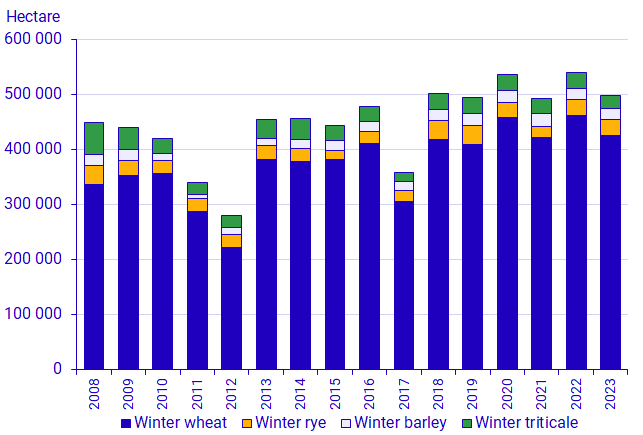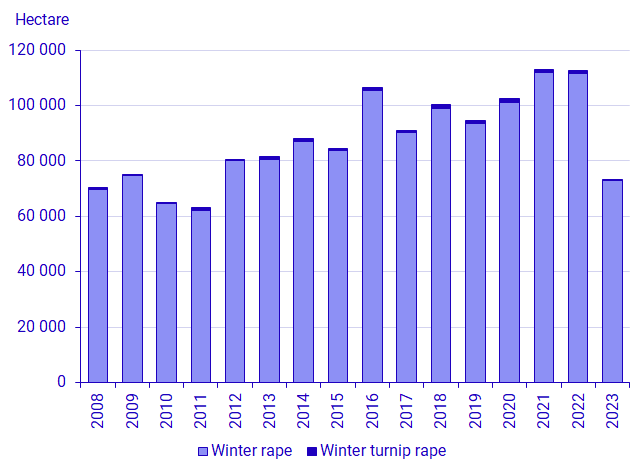Autumn-sown areas 2023
Autumn-sown areas of cereals and oilseed crops are 13 percent less than 2022
Statistical news from Statistics Sweden and Swedish Board of Agriculture 2023-11-30 8.00
This year’s autumn-sowing of cereals and oilseed crops amounted to 571 100 hectares. It is 13 percent less than 2022 and 7 percent less than the average in the past five years. One of the reasons for the reduction is that many farmers have not been able to autumn-sow as planned in parts of the country due to wet fields after this autumn´s heavy rainfall.
Winter wheat accounts for 75 percent of this year´s total autumn-sown area
In Sweden, 425 600 hectares of winter wheat were sown this autumn, which is 8 percent less than last year. At national level, the 2023 winter wheat areas were 2 percent less than average in the five past autumns, but 6 percent larger than the ten-year average. Large autumn-sown areas are beneficial for many reasons, not least because they help reduce nutrition losses from arable land.
Winter rye areas are comparable with last autumn´s areas
The autumn-sown area of rye is estimated to be 29 800 hectares and is comparable with last autumn´s areas.
Winter barley and winter triticale areas are less than last year´s areas
The winter barley areas are estimated to be 19 900 hectares, which is 3 percent less than last year´s areas and 8 percent less compared with the five-year average. The autumn-sown areas of triticale are estimated to be 22 700 hectares, which is 21 percent less last year’s areas.
Winter rape areas are less than last year´s areas
Winter rape areas are estimated to be 72 800 hectares, which is 35 percent less than last autumn´s large areas and 30 percent less than the five-year average. Winter turnip areas are estimated to be 300 hectares.
Organically cultivated autumn-sown areas are less than last autumn´s areas
Total autumn-sown areas cultivated organically are estimated to be 38 200 hectares, which is 30 percent less than last autumn’s areas, but 27 percent less than the five-year average. There were 25 400 hectares of organically cultivated winter wheat which is 29 percent less than last year’s areas and 23 percent less than the five-year average. The winter wheat area also includes 400 hectares of organically cultivated winter spelt.
Wet weather causes less autumn-sowing
Many farmers have stated that they had planned to sow much larger areas of autumn-crops than they were able to sow, due to wet soils after the autumn´s heavy rainfall.
Publication
More detailed information with a presentation by county and production area is published in a statistical report on the Swedish Board of Agriculture website, www.jordbruksverket.se, under “Statistik” in Swedish. The statistics on autumn sown areas are also available in the Swedish Board of Agriculture’s statistical database. The information is based on a sample survey in which about 5 000 farmers submitted information to Statistics Sweden about autumn sown areas.
More about the statistics
Information about the quality of the statistics, production methods, tables and graphs are available on the websites of the Swedish Board of Agriculture and Statistics Sweden.


Note that the tables for cereals and oilseed crops use different scales.
Feel free to use the facts from this statistical news but remember to state Source: Statistics Sweden.
